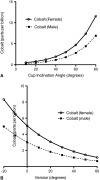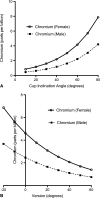Insufficient acetabular version increases blood metal ion levels after metal-on-metal hip resurfacing
- PMID: 21656317
- PMCID: PMC3148360
- DOI: 10.1007/s11999-011-1930-y
Insufficient acetabular version increases blood metal ion levels after metal-on-metal hip resurfacing
Abstract
Background: Many factors affect the blood metal ion levels after metal-on-metal (MOM) hip arthroplasty. The main surgically adjustable variable is the amount of coverage of the head provided by the cup which is a function of the inclination and version angles. However, most studies have used plain radiographs which have questionable precision and accuracy, particularly for version and large diameter metal heads; further, these studies do not simultaneously assess version and inclination. Thus the relationship between version and blood metal ions levels has not been resolved.
Questions/purposes: We determined whether cup inclination and version influence blood metal ion levels while adjusting for age at assessment, gender, body mass index, horizontal femoral offset, head size, manufacturer hip type, and Oxford hip score.
Patients and methods: We prospectively followed 100 individuals (51 females, 49 males) with unilateral MOM hip resurfacing who underwent clinical assessment, CT scanning, and blood metal ion measurement. Multiple regression analysis was used to determine which variables were predictors of blood metal ion levels and to model the effect of these variables.
Results: Only cup inclination, version angles, and gender influenced blood cobalt or chromium levels. Cobalt and chromium levels positively correlated with inclination angle and negatively correlated with version angle. The effect of changes in version angle was less than for inclination angle. Based on our observations, we developed a formula to predict the effect of these parameters on metal ion levels.
Conclusions: Our data suggest insufficient cup version can cause high blood metal ions after MOM hip arthroplasty. We were unable to show that excessive version caused high levels.
Level of evidence: Level II, prognostic study. See Guidelines for Authors for a complete description of levels of evidence.
Figures




Comment in
-
2D measurements of cup orientation are less reliable than 3D measurements (Acta Orthop 2015; 86 (4): 485-90.).Acta Orthop. 2016 Jun;87(3):314-7. doi: 10.3109/17453674.2016.1156932. Epub 2016 Mar 15. Acta Orthop. 2016. PMID: 26979301 Free PMC article. No abstract available.
References
-
- Angadji A, Royle M, Collins SN, Shelton JC. Influence of cup orientation on the wear performance of metal-on-metal hip replacements. Proc Inst Mech Eng H. 2009;223:449–457. - PubMed
-
- Antoniou J, Zukor DJ, Mwale F, Minarik W, Petit A, Huk OL. Metal ion levels in the blood of patients after hip resurfacing: a comparison between twenty-eight and thirty-six-millimeter-head metal-on-metal prostheses. J Bone Joint Surg Am. 2008;90(suppl 3):142–148. doi: 10.2106/JBJS.H.00442. - DOI - PubMed
-
- Bowsher JG, Hussain A, Williams PA, Shelton JC. Metal-on-metal hip simulator study of increased wear particle surface area due to ‘severe’ patient activity. Proc Inst Mech Eng [H]. 2006;220:279–287. - PubMed
Publication types
MeSH terms
Substances
LinkOut - more resources
Full Text Sources
Medical
Research Materials

